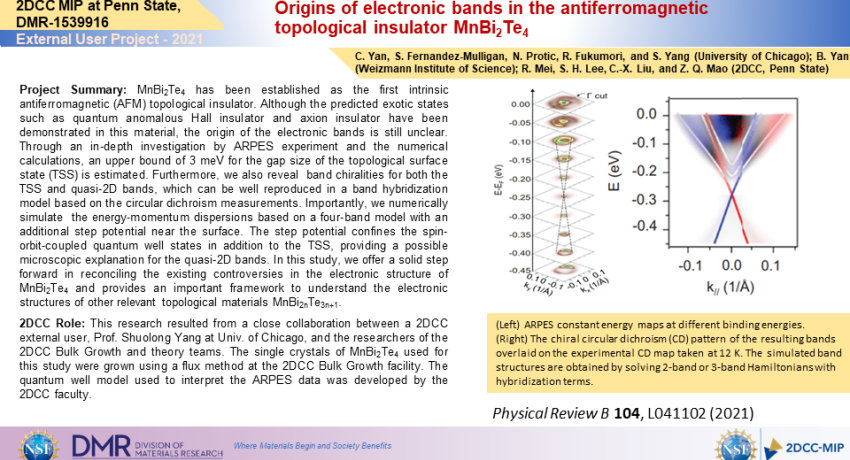Project Summary: MnBi2Te4 has been established as the first intrinsic antiferromagnetic (AFM) topological insulator. Although the predicted exotic states such as quantum anomalous Hall insulator and axion insulator have been demonstrated in this material, the origin of the electronic bands is still unclear. Through an in-depth investigation by ARPES experiment and the numerical calculations, an upper bound of 3 meV for the gap size of the topological surface state (TSS) is estimated. Furthermore, we also reveal band chiralities for both the TSS and quasi-2D bands, which can be well reproduced in a band hybridization model based on the circular dichroism measurements. Importantly, we numerically simulate the energy-momentum dispersions based on a four-band model with an additional step potential near the surface. The step potential confines the spin-orbit-coupled quantum well states in addition to the TSS, providing a possible microscopic explanation for the quasi-2D bands. In this study, we offer a solid step forward in reconciling the existing controversies in the electronic structure of MnBi2Te4 and provides an important framework to understand the electronic structures of other relevant topological materials MnBi2nTe3n+1.
2DCC Role: This research resulted from a close collaboration between a 2DCC external user, Prof. Shuolong Yang at Univ. of Chicago, and the researchers of the 2DCC Bulk Growth and theory teams. The single crystals of MnBi2Te4 used for this study were grown using a flux method at the 2DCC Bulk Growth facility. The quantum well model used to interpret the ARPES data was developed by the 2DCC faculty.
What Has Been Achieved: Succeeded in providing the origins of electronic bands in the antiferromagnetic topological insulator MnBi2Te4.
Importance of the Achievement: Offer a solid step forward in reconciling the existing controversies in the electronic structure of MnBi2Te4 and provides an important framework to understand the electronic structures of other relevant topological materials MnBi2nTe3n+1.
Unique Feature(s) of the MIP that Enabled this Achievement: Synthesis of high-quality MnBi2Te4 crystals is extremely challenging due to the disorders caused by its non-stoichiometry composition. The 2DCC has developed a protocol to grow MnBi2Te4 single crystals with good quality. The collaboration between the user, the 2DCC synthesis and theory teams enables this work.
(If Applicable) Publication:
Chenhui Yan , Sebastian Fernandez-Mulligan, Ruobing Mei, Seng Huat Lee, Nikola Protic, Rikuto Fukumori, Binghai Yan, Chaoxing Liu, Zhiqiang Mao, and Shuolong Yang, Physical Review B 104, L041102 (2021). DOI: 10.1103/PhysRevB.104.L041102
The financial support for sample preparation was provided by the National Science Foundation through the Penn State 2D Crystal Consortium-Materials Innovation Platform (2DCCMIP) under NSF cooperative agreement DMR-1539916. C. X. L. and R. B. M. acknowledge the support of the US Department of Energy (Grant No. DESC0019064) for the development of the theoretical model.
